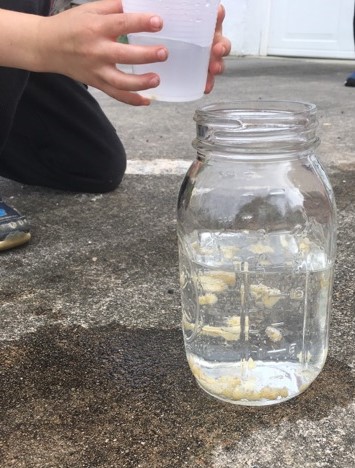If you are planning on making popcorn for a Movie Night, why not try this experiment first that will help you learn about chemical reactions? Things can get messy with this experiment, so it’s best to do it outside or set your container in a deep pan to catch any overflow.
Materials:
Tall glass or clear plastic container, water, baking soda, popcorn kernels, vinegar, measuring cups and spoons.
Optional —Clock or stopwatch, thermometer
Steps:
- Start by filling your container with 2 cups of water. Stir in 2 tablespoons of baking soda; most of it will sink to the bottom, so try to mix it well!
- Add a handful of popcorn kernels to the mixture. Did the kernels sink or float? Why did that happen?
- Get ready … add about 1 cup of vinegar and watch what happens!
The popcorn “dances” because of a chemical reaction between the baking soda and the vinegar: When the baking soda (a base) and the vinegar (an acid) combine, they disappear and instead create two new things called sodium acetate (a kind of salt crystal) and carbon dioxide (a gas.) It’s the carbon dioxide gas bubbles that cling to the popcorn kernels and lift them to the top of the water, where the bubbles then pop, and the popcorn sinks back down to the bottom of the container.
The popcorn will dance for a few minutes before the reaction ends, but here are some other ideas to continue the experiment:
- Using a clock or stopwatch, time the reaction. Is there a way you could speed up the reaction or make the popcorn dance longer?
- In any chemical reaction, there is usually a temperature change too. The dancing popcorn reaction is called an endothermic reaction: Heat energy is being absorbed by the reaction, making the glass feel cooler. The opposite is an exothermic reaction: Heat energy is given off, making the area around it hotter. Try using a thermometer to measure the temperature of the solution before and after adding the vinegar, and again at the end of the reaction.
- Try experimenting with adding more popcorn kernels or other small items in your bubbly water. (Hint — raisins are also great!) Make a hypothesis (or a guess about what will happen using the information you already know) for each different item: Will this item float, dance, or just sink to the bottom?


Recent Comments